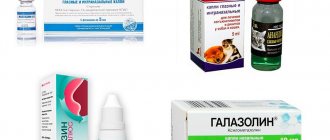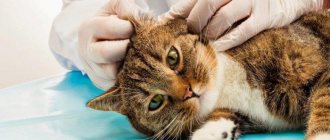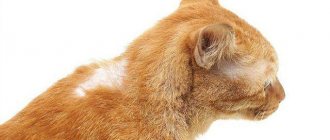Skin diseases in cats are one of the most common problems that both veterinarians and owners of furry and hairless pets have to deal with. Cats who visit the street from time to time are most at risk of getting skin diseases. Animals that permanently live in an apartment are also not immune from them.
Despite their prevalence, skin diseases in cats require serious long-term treatment, many of them can lead to serious consequences and seriously undermine the health and immunity of the animal. And some pose a danger to human health.
Therefore, at the first signs of pathology, the cat must be shown to a veterinarian. Only a doctor can make a correct diagnosis and prescribe an effective treatment for skin diseases in cats that is safe for the pet and the owner.
Why do sores with an odor occur in cats?
Sores on the body of a cat can form for various reasons. Not all ulcers and wounds will have odorous properties. They appear as a result of skin injury. While the damaged tissue is being restored, a protective film is formed on top. As healthy epidermis grows, this film dies, hardens and falls off.
Most often, wounds occur due to:
- allergic reaction;
- insect bites;
- mechanical damage (fights, cuts);
- skin diseases.
In unfavorable conditions, the healing process does not always go according to plan. A pet can scratch the problem area too much, bacteria will get into it, and the inflammation will intensify. Instead of regeneration, a process of even greater tissue destruction will begin with the formation of pus. The necrotic process in the abrasion is accompanied by an unpleasant aroma. The cat's body begins to exude a characteristic putrid odor.
Sores can occur due to excessive scratching of the cat.
Causes of impaired skin regeneration include:
- dirt ingress;
- decreased immunity;
- hormonal imbalance;
- high humidity in the place of residence;
- improper wound treatment.
All this leads to the proliferation of pathogenic microorganisms in damaged areas. Since the skin acts as a protective barrier for all internal systems, infection can quickly spread to all organs. In this case, the damage to health will become irreparable.
Common Skin Diseases in Cats
Sores on a cat’s skin can appear for external and internal reasons. Superficial irritations, consequences of bites, and allergies are easier to treat. Rashes caused by serious internal problems are much more difficult to eliminate. Timely diagnosis helps make therapy successful.
A sore on a cat’s body: why it appears and how to treat it
Diagnostic methods
Diagnosis of the disease is carried out only in a veterinary clinic. You should not listen to friends’ advice about what remedy to take to get rid of fungus, since many fungi are dangerous to humans, and the lack of timely and adequate therapy will have an extremely negative impact on the owner.
Only a specialist can determine the necessary treatment for fungus in cats. In order to identify the type of fungus that has affected the cat, the veterinarian takes a skin scraping at the site of the lesion. What kind of infection is occurring is determined very quickly, after which the right medicine is selected.
When a veterinary clinic has a powerful laboratory, they not only determine the type of fungus, but also determine what type of drugs it will be most sensitive to. Thanks to this, it is possible to carry out therapy with the most effective antifungal drugs.
© shutterstock
“Simple” skin diseases of cats
They are treated mainly externally. Rarely develop into advanced forms. Complications begin only after too long exposure to the irritant.
Flea dermatitis
Occurs after flea bites. The skin reacts to the toxic saliva of the parasite, which contains more than 15 allergens. The immune system begins to protect the body, so specific external reactions take place.
The disease is typical for all ages and breeds of cats. It occurs in kittens, but veterinarians note the vast majority of infections after a year. Free-ranging individuals are especially susceptible: fleas are transferred from other animals, grass, human clothing in the form of larvae or mature insects.
Flea dermatitis in a cat
The first symptom is restless scabies. Then blisters appear, scratches from scratching, and the coat becomes thinner. With further development, bad-smelling sores with pus form on the wounds.
more about the symptoms, diagnosis and treatment of flea dermatitis in the article on our website.
Cat acne
Acne occurs in cats on the chin, less often - near the nose and forehead. It is expressed by black and white comedones. In the area of infection, hair falls out and hard crusts appear. Over time, comedones open on their own, or the cat scratches them. Painful ulcers and pustules form, and bacteria begin to grow in the wound.
Acne occurs due to hormonal problems, genetically clogged sebaceous glands, and regular stressful situations. It also develops as a result of improper pet hygiene. A haircut and unsanitary conditions often result in inflammation of the hair follicles and clogged skin pores.
Acne on the chin of cats
Allergic reactions
With skin allergies, the immune system responds to substances entering the body that are difficult to cope with. Particles of household chemicals, products, components of ready-made food, fabric of bedding and cat clothing, dust, pollen cause a sharp flow of blood to the surface of the body, inflammation with pimples and itching. Complications in healing occur when scratching.
On a note! Too much contact with the allergen provokes asthmatic syndrome, granuloma and atopic dermatitis. Each of these pathologies is difficult to treat.
Symptoms: redness, itching, restlessness, rash, partial baldness, cough.
Allergic reactions on the cat's body
Eczema
Inflammation at the site of damage to the epidermis. The surface layer is destroyed due to poor hygiene, too harsh shampoos, parasites, strong friction of clothing and collar. Eczema occurs less frequently against the background of pathological processes in the liver, kidneys, gastrointestinal tract, endocrine and nervous systems. Eczema can be detected by scabies, blisters, nodules, peeling, red spots and crusts on the surface of the body. The skin may “sweat” locally. The animal loses weight, sometimes there is a fever and frequent urination.
Eczema occurs due to poor hygiene, too harsh shampoos, parasites, strong friction of clothes and collars
Ear mites (otodectosis)
The parasitic insect settles in the ear canals and canals, causing severe itching, redness, and fever. The cat often shakes its head and scratches its ears. Purulent discharge begins from the ears. The progressive process threatens with huge wounds on the head from scabies, inflammation of the ears, loss of balance and hearing. The running process can be determined by the head constantly tilted to the side.
Ear mites on a cat
Sarcoptic mange
Another disease from parasitic insects. Ticks of the genus Sarcoptes spread throughout the body. Due to their microscopic size, they are not noticed for a long time; the problem is considered pseudo-scabies. It is more common in dogs, but is easily transmitted to cats through constant contact.
On a note! Sarcoptic mange is transmitted to humans in the form of scabies, rashes and redness on the body.
The areas with bites become red, itchy, dry and flaky. Gradually, the hair falls off, the scabs fall off and ulcers with pus open. The average duration of the acute period is 4 months.
Advanced form of sarcoptic mange
Notoedrosis
Disease caused by ticks Notoedres cat. Bites are localized on the stomach, face, ears and groin. They appear as crusts and bubbles with liquid. Blisters quickly break out, form wounds, itch and become covered with purulent crusts. Hair falls out around the sores. In case of complications, the skin begins to crack and becomes very dry. Numerous fungi and bacteria settle in cracks.
Notoedrosis
Seborrhea
A consequence of disruption of the sebaceous glands. Fat accumulates on the surface of the skin, crusts dry out, the fur sticks together, and a foul odor is formed. The affected areas sometimes itch and crack. If ticks or fleas are present, pathogenic microflora spreads much faster.
Seborrhea occurs due to disruption of the sebaceous glands
Outwardly it looks like greasy fur with white flakes of dandruff.
Pyoderma
Bacterial infection that affects cats of any age. Older pets are especially susceptible. You can notice by a large number of small pustules on the skin, hair loss in patches. In place of the burst blisters, ulcers with growths form. The cat's body is very itchy (especially the face and stomach), and dried pus is visible on the fur.
Skin lesions in cats with pyoderma
Prevention of bedsores
Principles for preventing bedsores in dogs and cats:
- Animals, especially paralyzed ones, should lie on soft, springy bedding. This could be a special anti-decubitus bed, a thick mat, elastic fabric stretched over a wooden frame, and so on.
- Recumbent animals must be turned every two hours, and the condition of risk areas must be carefully monitored. You can also shave the hair in areas where bedsores are most likely to occur.
- All waste must be removed in a timely manner, and the animal must be kept clean.
- The bedding should always be clean, dry, and the room temperature should be comfortable for the pet.
- If the animal has diseases that aggravate the occurrence of bedsores (for example, diabetes mellitus, other disorders of the endocrine system), it is necessary to strengthen preventive measures.
Dangerous skin diseases of cats
Caused by internal pathologies or quickly progress to the stage of exacerbation, life-threatening.
Demodicosis
Microscopic mites are very active. Poisoning from bites spreads so quickly and abundantly that many cases of death are known.
In a mild form, white pimples with pus, partial baldness, red crusts, scratching and a small rash are noticeable on the skin. Over a long period of time, the cat easily scratches the pustules until they become ulcers, introduces infections and bacteria, becomes very weak, and loses appetite.
Demodicosis in cats
Ostiofolliculitis
Ulcers are located in hair follicles. The hair bag becomes clogged with sebum, becomes inflamed, and a staphylococcal bacillus settles inside the bag. If the disease is not treated at the beginning, it quickly progresses into acute furunculosis and peptic ulcer.
It can be detected by redness around the roots of the hairs, purulent pimples up to the size of a pea, burst blisters with crusts on top. The cat becomes restless and does not allow itself to be petted, as touching causes pain.
Ostiofolliculitis
Abscesses
Inflammation in the form of a soft cyst or lump on the skin. There is a lot of purulent exudate inside it. It starts to smell after it bursts and the liquid leaks onto the skin. The smell is especially pungent and unpleasant. Large abscesses greatly impair immunity. The cat may contract an infection during treatment. Therapy is also not fast. Drains are placed in the burst wound to remove all remaining fluid. We have to use strong antibiotics.
Abscesses on a cat's neck
Malasseziosis
Fungal infection. One of the most difficult to treat skin diseases in cats. Diagnosis is difficult and the course is protracted. Treatment requires heavy drugs that harm the rest of the body.
The characteristic smell gives off mold, spoiled cheese or milk. In the groin, near the back opening, behind the ears, near the mouth, claws and nose, you can find redness, rashes, moisture, and sores. The skin becomes painful, so the animal cannot be handled, hisses, and scratches. Relapses occur frequently and for a long time.
Malasseziasis is one of the most difficult to treat skin diseases in cats.
Ringworm
Pathology of an infectious fungal nature. Kittens and cats with oncology or weakened immunity after viruses are more often susceptible.
Fungal spores can be brought to your pet on street clothes or shoes. Spread occurs through household items and personal contact between animals.
The cat is actively losing hair on its head, limbs and tail. The skin in exposed areas peels, itches, becomes very red and pink. In these areas, pustules and crusts appear, which are easily scratched off with claws to open wounds. The disease can gain momentum for up to 2 years. With this course, the pet quickly weakens, loses weight, stops eating and may die from exhaustion. During this period, it is easiest to become infected with fatal infections, since the body does not have the strength to resist viruses. In severe cases, the ulcers spread to the paw pads and it becomes difficult to move.
Ringworm
Treatment without the participation of a doctor is impossible.
Atopic dermatitis
Chronic allergic reaction of the skin to irritants. The body reacts to dust, mold, pollen, household chemicals, and food with severe itching, rashes, hair loss, and ulcers. The cat will scratch especially a lot on the head, ears, chest, neck, lower abdomen and thighs. Dermatitis is severe and weakens the animal. Ulcers are constant and profuse. It is difficult to select living conditions and food for the safe living of a pet.
Atopic dermatitis is a chronic allergic reaction of the skin to irritants
Cushing's syndrome
A rare hormonal disease, a reaction to too high levels of cortisol in the blood. Side effect of pituitary disease, adrenal tumors, injections and oral corticosteroids.
The cat suffers from thinning skin, acne with a small amount of pus. It scratches them off, which can result in difficult-to-heal wounds. The disease causes gluttony, a swollen abdomen, constant thirst, frequent urination, lethargy, muscle weakness, and hair loss.
Treatment is long and difficult. A severe metabolic disorder in the body may occur, leading to exhaustion and diabetes.
Cushing's syndrome is a rare hormonal disease, a reaction to too high levels of cortisol in the blood.
Fungus in the ears
In cases where the fungus in a cat’s ears is diagnosed correctly, it is quite easy to treat, even if it takes a long time. After the cat is examined by a specialist and the presence of fungus is detected, the auricle is mechanically treated, during which a complete cleaning is carried out.
For a cat, this procedure is unpleasant, although not painful, and therefore, during it, considerable effort is required from the owner to restrain his raging pet.
© shutterstock
After the ears are cleaned, special antifungal drops are instilled into them, which the owner must then administer for a certain time, strictly following the recommendations. A noticeable improvement in the cat’s condition is noted after just a few days of therapy, as the itching is relieved very quickly. Full recovery usually occurs after completing a course of treatment for 2-3 weeks.
If the owners have discovered a fungus in their cat or they suspect it, they should not self-medicate, but it is important to take the pet to a good veterinary clinic as soon as possible.
Sometimes animal owners use traditional methods of treating the disease, which is a big mistake, since they can only cope with several types of fungi, and in other cases they only further damage the already inflamed and injured skin of the animal.
Treatment of skin diseases in cats
Treatment of all diseases must be carried out under the supervision of a veterinarian. Treatment regimens are selected based on age, weight, cause and may vary significantly. Self-medication is fraught with death and worsening of the situation.
Table. Treatment of skin diseases
| Disease | Treatment |
| Flea dermatitis | Complete destruction of fleas using shampoos, tablets, drops (“Advocate”, Beaphar, “Frontline”, “Bars”), disinfestation of places of residence (“Flyblock”, “Tsifoks”), washing wounds with “Miramistin”, lubrication with antibacterial ointments (“ Methyluracil, Levomekol) |
| Acne | Treatment with antiseptics (Miramistin, Chlorhexidine), washing with antibacterial shampoos (tar, special veterinary compounds), corticosteroids and antibiotics orally and locally for advanced cases (Amoxiclav, Kanamycin, Vetrimoxin, Prednisolone) |
| Allergic reactions | Taking antihistamines (Diphenhydramine, Cetirizine), antibiotics and corticosteroids for acute reactions (Dexamethasone, Prednisolone), washing with decoctions of chamomile, calendula, medicated shampoos from a veterinary pharmacy |
| Eczema | Taking antihistamines, vitamins and sedatives (Cat Bayun, Zirtek, Beaphar, Sanal), ointments (Tetracycline, Levomekol) |
| Ear mite | Regular cleansing of the ears (at least 2 times a day) with Miramistin, acaricidal drops according to the prescription (Otovedin), tampons with Levomekol in the ear canals after drops, sprinkling with streptocide on external wounds |
| Sarcoptic mange | Drops of "Stronghold" on the cat's withers according to instructions, cleaning of premises, hygiene |
| Notoedrosis | Bathing with acaricidal or keratolic shampoo (sold in the veterinary pharmacy Beaphar, "Bars"), local application of aversectin ointment, "Demos", aqueous emulsion of neocidol, drops of "Stronghold" or sulfur ointment, disinfestation of premises |
| Seborrhea | Degreasing and astringent shampoos (“Bars”, “Frontline”), treatment of combed wounds with brilliant green or “Streptocide” |
| Pyoderma | Antibacterial drugs orally (Sulf 120, Tsiprovet), antiseptic ointments and solutions for wounds (Hydrocortisone, Chlorhexidine, Belogent) |
| Demodicosis | Antiparasitic shampoos, washing lotions (“Bars”, “Bifar”, “Parastop”), wearing a flea and tick collar (“Bifar”, “Bars”), dusting the affected areas with tick powder (“Clandestine”), injections prescription antibiotics (Betamox, Xiclav), treatment of affected skin with Miramistin |
| Ostiofolliculitis | An antimicrobial drug orally (according to the results of culture "Sinulox"), treating the skin with an antiseptic (brilliant or alcohol solution), taking immunomodulators and vitamins according to prescription ("Sanal") |
| Abscesses | Washing wounds with Miramistin, applying Vishnevsky ointment to the site of the abscess |
| Malasseziosis | Washing with fungicidal shampoos (Bifar), wiping the skin with an antiseptic (Miramistin, Chlorhexidine), Levomekol on the affected areas, antibiotic therapy as prescribed (Econazole 1%, Amphotericin B 3%, Clortimazole 1 %, "Flucytosine" 10%) |
| Ringworm | Antifungal shampoos with miconazole, chlorhexidine (Api-san), lubricating the affected skin with Mycoseptin, Clotrimazole, Sanoderm, Yam, Nizoral, orally or injections of Fluconazole, Terbinafine, immunosuppressants in tablets or injections (“Vetom”, “Ribotan”, “Imunofan”), brilliant green for ulcers |
| Atopic dermatitis | Treatment of an internal provoking disease (kidney, liver, etc.), diet after an allergen test, antihistamines as prescribed by a doctor (Tavegil, Cetrin), soothing ointments or washing with chamomile solution |
| Cushing's syndrome | "Trilostane" as prescribed by a veterinarian (to suppress cortisol), removal of the adrenal glands or radiation therapy of the pituitary gland as prescribed, local antihistamine ointments for skin lesions ("Hydrocortisone", "Yam") |
Treatment of diseases is comprehensive. It is necessary to follow all the veterinarian's recommendations and perform all therapeutic actions.










